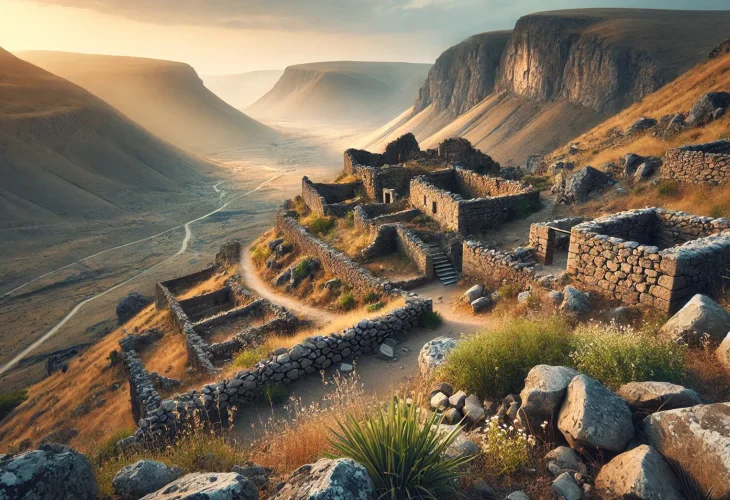Rediscovering Gamla: The Lost City Hidden for Millennia
On the 23rd of Tishrei, two days later, Titus the wicked, son of Vespasian, arrived with two hundred brave warriors to reinforce his father, Vespasian. Together, they stormed the city. Four thousand people were slaughtered in Gamla, while another five thousand leaped to their deaths into the surrounding chasms.

Amidst the chaos of war and with incredible achievements, by the grace of Hashem, researchers have managed to infiltrate ancient Jewish sites previously out of reach. In one such expedition, the researcher R' Zeev Ehrlich, may his memory be blessed, was killed.
A similar situation occurred in the land after the Six-Day War. Israel doubled its territory, and some sites remained unexamined due to lack of interest. Thus, the city of Gamla, where a heroic battle between Jews and Romans took place, was unknown. It was a story known to historians from the writings of Josephus Flavius, and nothing else.
Gamla did not surrender to the Romans and rebelled against them. Josephus Flavius described it as: "Gamla did not submit, for its inhabitants trusted in their stronghold, which was stronger than Yodfat. A sheer cliff rose from a high mountain there, and at the top, it took the form of a hump, spreading into a plateau above, declining steeply in front and behind. Its form resembled a camel, which gave it its name. Surrounded by precipices on three sides, its rocky terrain was impassable, except at the back, where the slope is more modest, yet even there the inhabitants dug a ditch to close off access to the city. The steep houses clung to it, giving the illusion of a city hanging on the abyss, plunging into the deep. The city faced southward, with the cliffs above rising immeasurably, where the fortress stood. Below it, the slope was left without a wall, plunging into a deep chasm. A water source was within the walls at the city's edge" (The Jewish War IV, 1).
Agrippa II, the last king of Judea, besieged Gamla for seven months without success. He retreated in despair while Josephus, commander of the Galilee, fortified the city with additional defenses, tunnels, and trenches. Then, Roman General Vespasian attacked with three legions in Elul 67 CE (three years before the destruction of the Second Temple).
Vespasian built a formidable, fortified camp on the opposite hill, starting a ramp to grant his soldiers access to the city. King Agrippa stood before the city, urging surrender to Vespasian. Stones were thrown at him, injuring his hand. Enraged, Vespasian ordered the ramp construction to continue more vigorously.
The ramp progressed slowly. The Romans used battering rams to breach the walls, and hundreds of soldiers climbed the rock into the city, forcing defenders to retreat to the high ground. The Romans, motivated by triumph, scaled in masses, but suddenly the Jews turned and, with shouts, charged downward, collapsing houses on the Romans climbing the cliff. Gamla resembled a volcanic eruption, throwing ballistae, house debris, and roofs into the abyss, taking Roman soldiers with them. Vespasian, one of the city’s first invaders, was trapped with few soldiers inside. There was a moment when it seemed even Vespasian himself might fall, but his guards encircled him and extracted him. Not so lucky was Iboteios, a brutal commander who tormented Jews. He was crushed by Gamla’s defenders, and the Romans retreated.
Though the Roman soldiers wished to abandon Gamla, Vespasian persisted and forced them to continue the siege, despite the immense difficulty of entry. For a month, the Romans laid siege to Gamla, and as the food and water dwindled, many defenders fled through the caves to other cities. On the night of Hoshana Rabbah, a month after the siege began, three soldiers from the Thirteenth Legion stealthily reached Gamla's watchtower, in total darkness. They undermined its foundations, causing the tower to collapse into the abyss with its guards. Vespasian still feared to approach the city. Two days later, on the 23rd of Tishrei, Titus the wicked arrived with two hundred brave warriors to reinforce his father, Vespasian. Together, they stormed the city, exploiting strong winds that greatly hindered the defenders. Four thousand people were slaughtered in Gamla, while another five thousand leaped to their deaths into the surrounding chasms.
Although this horrific story was known to historians, no one pinpointed Gamla’s location for two millennia. In 1911, the German archaeologist Gustav Dalman of the "German Evangelical Institute for the Study of the Holy Land" identified Gamla at Tell ed-Draa, near the Yarmouk River. Jewish researchers found this identification inconsistent with Josephus's description, which stated that Gamla faced Migdal, a view impossible from Tell ed-Draa. Gamla remained a tale.
Months after the Six-Day War, when Israeli forces, through Divine grace, captured the Golan Heights, 23-year-old Yitzhaki Gal, a member of Kibbutz Afikim, explored the area. As he traversed the Daliyot stream, a hump-shaped mountain loomed ahead. He recalled Josephus’s description and wondered: Could this be Gamla? Could a once-bustling Jewish city have sat atop this barren, windswept hill, where a significant battle resulted in the deaths of countless warriors?
Archaeologist Shemaryahu Talmon came and began excavations there. For 14 years, Tell Gamla was unearthed, confirming the historical texts. Numerous relics of the Jewish settlement emerged, including Gamla's synagogue, sling stones, arrowheads, Jewish coins, an oil press, and a mikveh. Today, Tell Gamla is a national park, visited by thousands annually.

